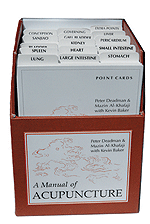
by Peter Deadman, Mazin Al-Khafaji, Kevin Baker
Product Description
Once in a great while an extraordinary book is published that sets an entirely new standard in its field. A Manual of Acupuncture, published by Journal of Chinese Medicine Publications, is just such a book. Painstakingly researched over many years by Peter Deadman, editor-in-chief of The Journal of Chinese Medicine, and colleagues Mazin Al-Khafaji and Kevin Baker, this book has become the primary reference in the West for the study of acupuncture points and channels.
With the subtle use of color to illustrate the acupuncture points and anatomical features, the new second edition of A Manual of Acupuncture is even more attractive and user-friendly than the first.
Introductory chapters describe and illustrate the channels and collaterals, the various categories of points, and methods of selection, location, and needling. Ensuing chapters present each of the points of the 14 channels as well as the extra (miscellaneous) points, identified by their English and pinyin names, and Chinese characters. Each point is located in accordance with the most exacting anatomical standards to be found in any Western textbook.
For each point there is a dedicated drawing, followed by regional body drawings. The quality of the 500 drawings is far superior to those in any other TCM text. There are also practical pointers for finding and needling the points, and cautionary information about what to avoid. In addition to point indexes by their English and pinyin names, there is an index identifying every part of the body reached by each of the channels, and separate indexes of point indications listed according to both TCM and biomedical symptoms.
About the Author
Peter Deadman studied acupuncture and Chinese herbal medicine in England and China, and for the past 20 years has been in private practice in Brighton, England. In 1979 he founded The Journal of Chinese Medicine which he edits, writes for, and publishes. He has also been a teacher of acupuncture and Chinese medicine, and has lectured widely throughout the United Kingdom, Europe, Israel, Australia, and the United States.
Mazin Al-Khafaji studied acupuncture in England and China, followed by intensive studies in modern and medical Chinese in Taiwan. In 1987 he graduated as a Doctor of Chinese Medicine from the Shanghai College of Traditional Chinese Medicine, and has since been in private practice in Brighton where he specializes in dermatology. Dr. Al-Khafaji is also a frequent lecturer in Chinese medicine in the United Kingdom and Europe.
Kevin Baker qualified in Medicine at Cambridge University and St. George's Hospital Medical School in 1979, subsequently specializing in Accident and Emergency Medicine and Surgery. He became a member of the Royal College of Physicians in London in 1983, and a Fellow of the Royal College of Surgeons in Edinburgh in 1986. Thereafter, he pursued studies in acupuncture in England and China, which he currently practices in addition to psychotherapy and general medicine. --This text refers to an alternate Hardcover edition.
Please also see the Acupuncture Point Cards, the companion card set to A Manual of Acupuncture, and A Manual of Acupuncture CD-ROM.
by Peter Deadman, Mazin Al-Khafaji, Kevin Baker

From the Publisher
A companion to A Manual of Acupuncture, there are 384 durable point reference and study cards covering all 391 of the 14 channel and extra (miscellaneous) points. Each card measures 4" x 6", and most are devoted to a single point. This second edition of the point cards offers a new terra cotta storage case, two-color cards, the addition of pinyin accents, and updated point locations and location notes to match the latest edition of A Manual of Acupuncture.
The front of each card presents a dedicated illustration of the point showing its anatomical location. The back presents the English and Chinese names (in both pinyin and Chinese characters), the special categories or groupings to which the point belongs, the principal actions and clinical indications, and advice about locating and needling the point, including precautions. Additional cards illustrate the cun measuring system, needling directions, tables of point categories, and a glossary of terms. The cards are boxed in a very handsome, sturdy, and easy-to-access storage case with tabbed dividers.
by Peter Deadman, Mazin Al-Khafaji, Kevin Baker
Please select your location: